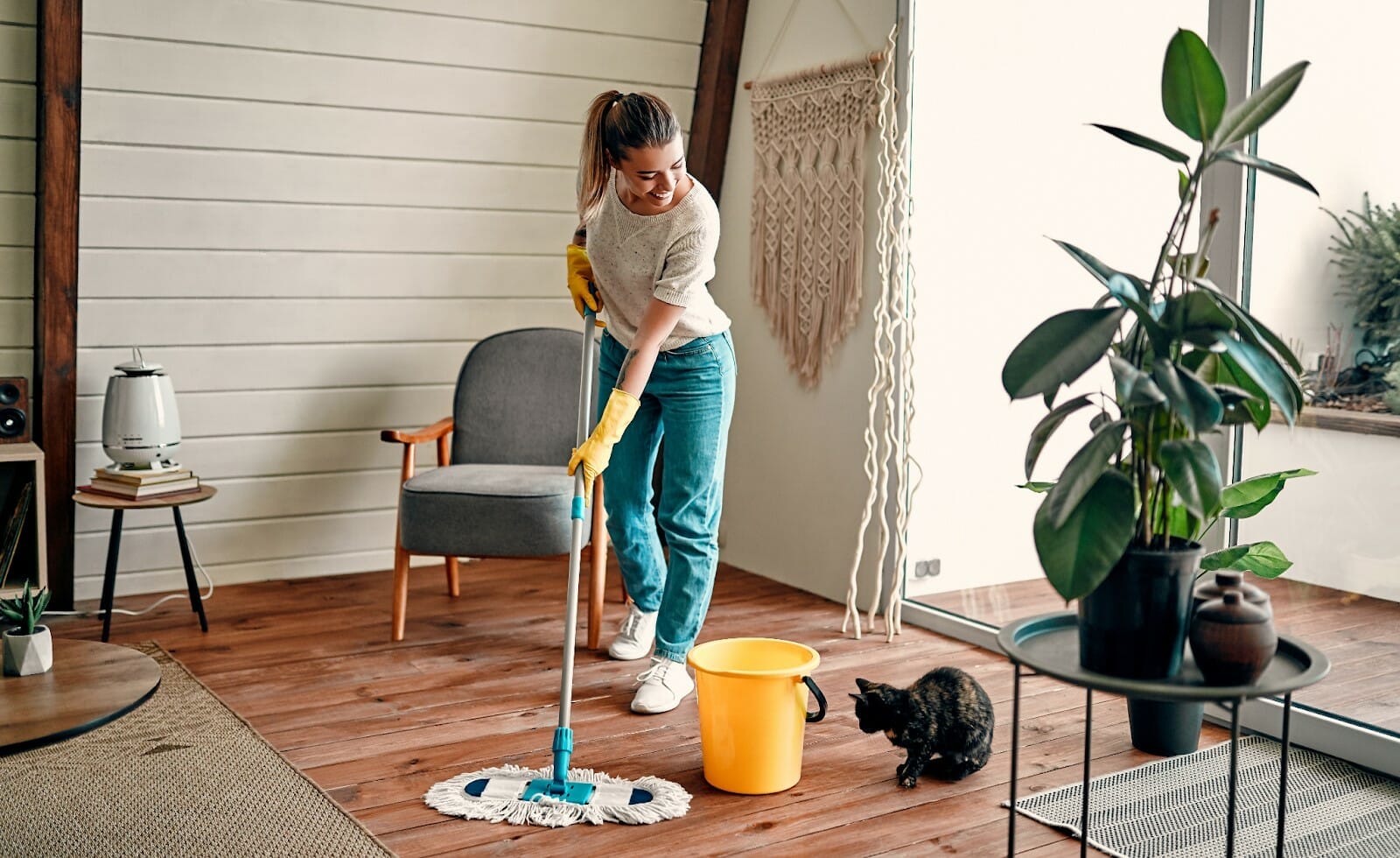Get started on your journey to living in a home that feels comfortable and welcoming.
Here are the 5 steps to efficient cleaning:

- Evaluate the Situation - Find your home’s trouble spots.
- Set Realistic Goals - Be specific and start with baby steps so you’re motivated to keep going.
- Pick Your Timeline - If you create individual timelines for each task, rather than one large one for the whole home, you’re more likely to stick to them.
- Decide Where to Start - Remember those trouble spots? They’re an excellent place to start and provide a clear end goal.
- Use Different Methods to Get the Job Done - There’s a lot of different strategies for cleaning. Pick what works for you and stick with it.
Step 1: Evaluate the Situation
Some people may hang onto excess items or animals that can compromise the health and
safety of the home. It’s important to keep up on cleaning and pay close attention to your common trouble spots so your home can remain safe and healthy. Common categories that stack up easily include:
Books
Are you holding onto books you’ll never get to? Do you have stacks of books you will probably never open again?

Food Items
Do you find yourself stocking up on certain foods, even if you can’t finish them before they expire? Are your cupboards filled with ingredients you don’t use?
Paper
Do you have stacks of old documents you don’t need anymore? Can you throw them away, or create a filing system for things you don’t have a digital record of?
Shopping
Do you have items in your closet that still have the price tags attached? Do you find yourself buying and stowing things you don’t intend to use?
Animals

Do you have more animals in your home than you can care for? Sometimes people rescue animals out of compassion, but do not have the space or resources to care for all of them. If you struggle caring for your animals, you may want to evaluate your space and consider finding new homes for some of them.
Trash
Do you find yourself searching for free items left in others’ trash, or struggling to part with your garbage? Some people struggle to part with trash, whether their own or what they’ve found. However, trash can quickly create dangerous health situations by attracting pests.
Step 2: Set Realistic Goals
Once you’ve identified what you want to change, it’s easy to get carried away with lofty plans. However, if you try to do too much at once, you can get overwhelmed and give up quickly.
Step 3: Pick Your Timeline

Don’t expect to finish everything in one weekend. Remember, it’s a process!
Rather than saying you’ll finish the entire house by a certain date, give yourself smaller deadlines and plenty of space. If you’re not sure how long something will take, set a daily habit goal for yourself. You can set a timer for 5-15 minutes, returning to the same area each day until it’s finished.
Easy does it!
Decluttering your home is a marathon, not a sprint! Don’t burn yourself out at the beginning. Keep it small, steady, and consistent.
Step 4: Decide Where to Start
Sometimes the hardest part of undertaking a big project is getting started! Get the momentum going by deciding what your first step will be.

Make it easier on yourself by picking a spot you can finish quickly. Accumulating some wins will help you feel good about your progress and strengthen your motivation and confidence.
Breaking your goals down into bite-size, achievable increments is a great strategy. Rather than saying “I’ll clean the bathroom first,” focus on decluttering the top drawer.
Once that is finished, pat yourself on the back and move on to the next drawer.
Step 5: Use Different Methods to Get the Job Done

There are numerous decluttering strategies out there. Below, we’ve compiled what we found to be the most effective strategies for your use. Some will work for your personal strengths and needs, and others won’t.
Keep testing the cleaning methods listed below until you find something that resonates with YOU and helps you achieve your goals.
Try the One-Drawer-a-Day Declutter Challenge.

Each day, choose a drawer or other small space in your home and set a time for 5-15 minutes. Work on that space until your timer goes off, and then move on with your day!
Once you’ve finished a space, you can move on to the next area on your list.
The one-drawer-a-day method works especially well for people with ADHD or others who may quickly get distracted.
Ask Yourself if You’ve Used it in the Last Year
Sometimes, we hang onto things for years, thinking we’ll need them eventually. With this method, we introduce ways to track if items have been used in the last year. If not, they’re thrown out or donated.

The next time you’re decluttering, ask yourself if you’ve used an item in the last year. If not, get rid of it.
If you’re sorting clothes, it can be helpful to turn all the hangers backward at the beginning of a season. Once you’ve worn something, you can hang it up the regular way.
Once that season is over, look through the closet and remove all the clothes still on backward-facing hangers—these are the pieces you wound up not using.
Check for Multiples
No matter how useful something is, having too much is unhelpful. If you have extras of something, donate them. Many organizations take extra items, and sometimes these donations are even tax-deductible.
These organizations are all good options to look into when donating extra items:
- Animal rescues
- Women and children’s shelters
- Veterans association
- At-risk youth groups
- Churches, temples, synagogues, mosques, etc.
- The Boys and Girls Club
Follow the OHIO rule

OHIO stands for Only Handle It Once. This method is particularly useful for mail and email. Don’t let things pile up. When you open your mail, you have three options:
- Throw it away
- Take action on it
- Scan it for your records
Once you have a digital record of something, you can throw away the paper copy and know that you’ll never lose it.
Follow KonMari
Kondo’s method of decluttering involves asking yourself if different items “spark joy.” In her bestselling book, The Life-Changing Magic of Tidying Up, Kondo offers a unique process.
She advises going through your homes, touching each item you own, and asking yourself if it sparks joy. Often, she says, we are attached to our emotions and memories surrounding an object, and we don’t need the object itself to enjoy those emotions and memories.
Search within yourself.

While going through each individual item can feel overwhelming, as you make your way through the different spaces in your home, take an extra minute with the items that feel hard to part with.
Ask yourself if that item truly sparks joy. If you’re keeping it for any other reason (anxiety, guilt, fear), let it go.
Try Swedish Death Cleaning
One of the main premises of Swedish death cleaning is consideration for your loved ones who will need to deal with your belongings after your passing.
While it may seem morbid, in reality, choosing to downsize can lighten the burden for others in the future. Swedish death cleaning emphasizes taking your time and mindfully evaluating what you still need.

Use the 4-Box Technique
For the 4-box technique, label four different boxes with:
Keep
If you’re keeping it, put it in the keep box.
Donate
If you don’t need it but it’s still in good shape, put it in the donation box.

Trash
If you don’t need it and it isn’t in good condition to donate, put it in the trash box.
Store
If you need it in a certain season, but not this current season (think baby gear if you’re planning on having another child, seasonal decor, winter clothing, etc.), put it in the store box.
With your four boxes, move to the first space you want to declutter and put items in the appropriate box. Once you’re finished with a space, empty the boxes before you move to the next space. Put away the keep items, throw out the trash items, and so on.
Try the 21-Item Toss Challenge

For a motivating win to get your sense of accomplishment up, do a quick 21-item toss.
Grab a trash bag and walk through your house, picking up the first 21 things you see that you don’t need anymore and throwing them away. If you make this a habit, you can quickly clear out things you no longer need and make a big difference in your space.
It’s a great excuse to get up from your desk for a few minutes or fill the time during a commercial break. You can enlist your kids or partner to help too—or race to see who can toss 21 items first!
Give Stored Items an Expiration Date
If you’re saving something for a rainy day, put it on a firm deadline. Box up the items you think you’ll need someday and write an expiration date on the outside of the box.
If you haven’t gone looking for the items by that date, simply donate or throw away the box. Put a reminder in your phone or calendar so you don’t leave the box gathering dust in your garage for years.

Play the Zone
For a week-long challenge, choose 7 manageable areas you want to tackle. Each day for a week, clean one of your zones. Make sure these areas are small so you don’t get overwhelmed—you want to set yourself up to win by picking things that can be accomplished in a day!
Give it a Home… but if it Won’t Fit, Make it Quit
Sometimes we need to make a few purchases in order to organize our homes. It makes it even harder to clean things up if you’re dealing with:
- Small, loose items
- Piles of toys with nowhere to put them
- Clothes you need hangers for
Finding a storage bin, new hangers, or another organizer to corral these items can make all the difference. But beware, don’t let shopping for organizational solutions become a new way to clutter up your home.
Recognize that if you are constantly buying new bookshelves or storage bins, it’s probably time to go through your items and get rid of some of them.
Ask Yourself Mindful Questions
Getting rid of things can be a painful process, but understanding your reasons for decluttering increases your motivation. Ask yourself these 12 questions to decide if something deserves a spot in your home:
- Is this item something I’m currently using?
- Is this something I would buy right now if I saw it in a store?
- Is the thought of wasting money keeping me from getting rid of this item?
- Is this something I love? (Does it “spark joy?”)
- Am I keeping this for sentimental reasons?
- Do I have future plans for using this item or am I saving it “just in case”?
- Do I have multiples of this item?
- When I wear this, do I feel confident?
- Could someone else use this more than I do?
- If I were moving to a new home, would I pack this and bring it with me?
- Is this item worth the time I spend maintaining, cleaning, and/or storing it?
- Could I make money selling this item?


